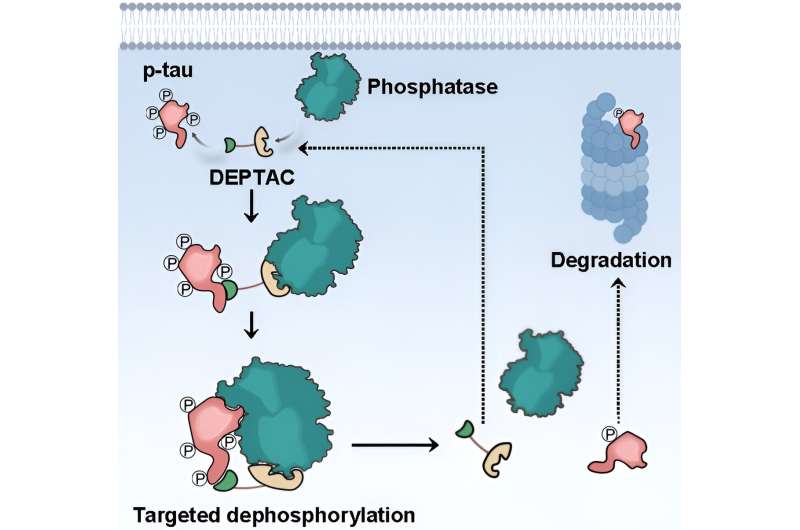This article has been reviewed according to Science X's editorial process and policies. Editors have highlighted the following attributes while ensuring the content's credibility:
fact-checked
trusted source
proofread
Generation of tau dephosphorylation-targeting chimeras for the treatment of tauopathies

Accumulation of pathologic tau protein plays a pivotal role in the neurodegeneration of Alzheimer's disease (AD) and many other tauopathies. Thus, amelioration of pathological tau aggregates in the brain is an important direction for the development of drugs. However, since tau per se plays multifaceted physiological roles in maintaining cell structure and functions, the traditional strategies targeting the general form of tau proteins might be somewhat arbitrary.
As the pathological hyperphosphorylation of tau initiates the formation of neurofibrillary tangles and neurodegeneration in tauopathies, specific downregulation of tau phosphorylation might be more refined for the therapy of these diseases. However, direct use of either tau kinase inhibitors or phosphatase activators should produce unacceptable toxic side effects because each of these enzymes concurrently modulates numerous signaling pathways aside from tau.
The study, published in the Science Bulletin, was led by Prof. Jian-Zhi Wang (Department of Pathophysiology, Tongji Medical College, Huazhong University of Science and Technology), Prof. Jie Zheng (Department of Neurobiology, School of Basic Medical Sciences, Peking University) and Prof. Xiaochuan Wang (Department of Pathophysiology, Tongji Medical College, Huazhong University of Science and Technology).
To realize the specific dephosphorylation of tau, Jian-Zhi Wang and her teams have conceptualized a strategy, Dephosphorylation-targeting chimera (DEPTAC), which is capable of specifically hijacking phosphatases to tau to debilitate its hyperphosphorylation. The DEPTAC consists of the following motifs: (1) a "warhead" specifically recognizing and binding tau, (2) an "anchor" for recruiting phosphatase, (3) inter-motifs linker, (4) a cell membrane-penetrating sequence, if necessary.
First, they conducted the step-by-step optimization of each constituent motif to generate new DEPTACs, which showed reasonable efficacy in facilitating the dephosphorylation and subsequent clearance of pathological tau.
They then conducted further exploration on one of the selected chimeras, D16. They found that D16 showed significant efficiency in rescuing the neurodegeneration caused by neurotoxic K18-tau seeds in vitro. Moreover, intravenous administration of D16 also alleviated tau pathology in the brain and improved memory deficits in AD mice.
These results suggested DEPTACs as targeted modulators of tau hyperphosphorylation, which hold therapeutic potential for AD and other tauopathies.
More information: Jingfen Su et al, Generation of tau dephosphorylation-targeting chimeras for the treatment of Alzheimer's disease and related tauopathies, Science Bulletin (2024). DOI: 10.1016/j.scib.2024.01.019



















